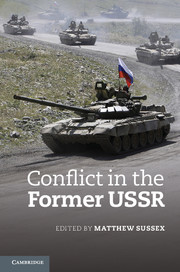Book contents
- Frontmatter
- Contents
- Maps
- Contributors
- Acknowledgements
- Abbreviations
- Map
- 1 Introduction
- 2 The return of imperial Russia
- 3 The shape of the security order in the former USSR
- 4 Great powers and small wars in the Caucasus
- 5 The Russo-Georgian war
- 6 Why not more conflict in the former USSR?
- 7 Transnational crime, corruption and conflict in Russia and the former USSR
- 8 The transformation of war?
- 9 Conclusions
- Bibliography
- Index
- References
3 - The shape of the security order in the former USSR
Published online by Cambridge University Press: 05 November 2012
- Frontmatter
- Contents
- Maps
- Contributors
- Acknowledgements
- Abbreviations
- Map
- 1 Introduction
- 2 The return of imperial Russia
- 3 The shape of the security order in the former USSR
- 4 Great powers and small wars in the Caucasus
- 5 The Russo-Georgian war
- 6 Why not more conflict in the former USSR?
- 7 Transnational crime, corruption and conflict in Russia and the former USSR
- 8 The transformation of war?
- 9 Conclusions
- Bibliography
- Index
- References
Summary
It is symptomatic of the uncertainty surrounding contemporary international politics that two decades after a ‘New World Order’ was proclaimed, key questions about sources of insecurity remain unanswered. With that uncertainty in mind, this chapter examines the security order emerging in the territory of the former USSR, with a specific focus on the roles played by different institutions and organisations. It finds that the former Soviet space is best characterised as a zone reflecting what I call Russian ‘constrained primacy’. There are several reasons for this. To begin with, the prospects for the development of an overarching form of security architecture that satisfies the strategic objectives of regional and extra-regional powers remain bleak. The primary political and military-strategic organisations shaping the former USSR still have fundamentally divergent purposes, with those championed by Moscow acting as vehicles for bloc consolidation, while those reflecting Western interests undermine Russia’s attempts to cement its hegemony. Moreover, it is unlikely that institutions promoting economic interdependence can quickly be leveraged to build greater trust and reciprocity, due to the simple fact that actors both within the region and outside it continue to use trade strategically. Finally, recent attempts to propose new types of architecture to manage the post-Soviet space (and European security in general) have fallen prey to fundamental disagreements. As a consequence, the region faces a continued complex balance between a Russian state with rising power but declining centrifugal pull, and the use of primarily economic incentives by external actors to encourage smaller states into multi-vector foreign policies.
To examine this I ask three questions. First, what are the strategic preferences of Russia, as the largest power after the collapse of the USSR, and how has Moscow gone about embedding its regional eminence? Second, is there evidence that regional actors are learning to live with the constraints of interdependence, or are economic institutions largely instruments for relative gains? Third, I examine the effects of external pressure on Russia, and ask: to what extent is Russia regionally constrained?
- Type
- Chapter
- Information
- Conflict in the Former USSR , pp. 35 - 63Publisher: Cambridge University PressPrint publication year: 2012
References
- 4
- Cited by



